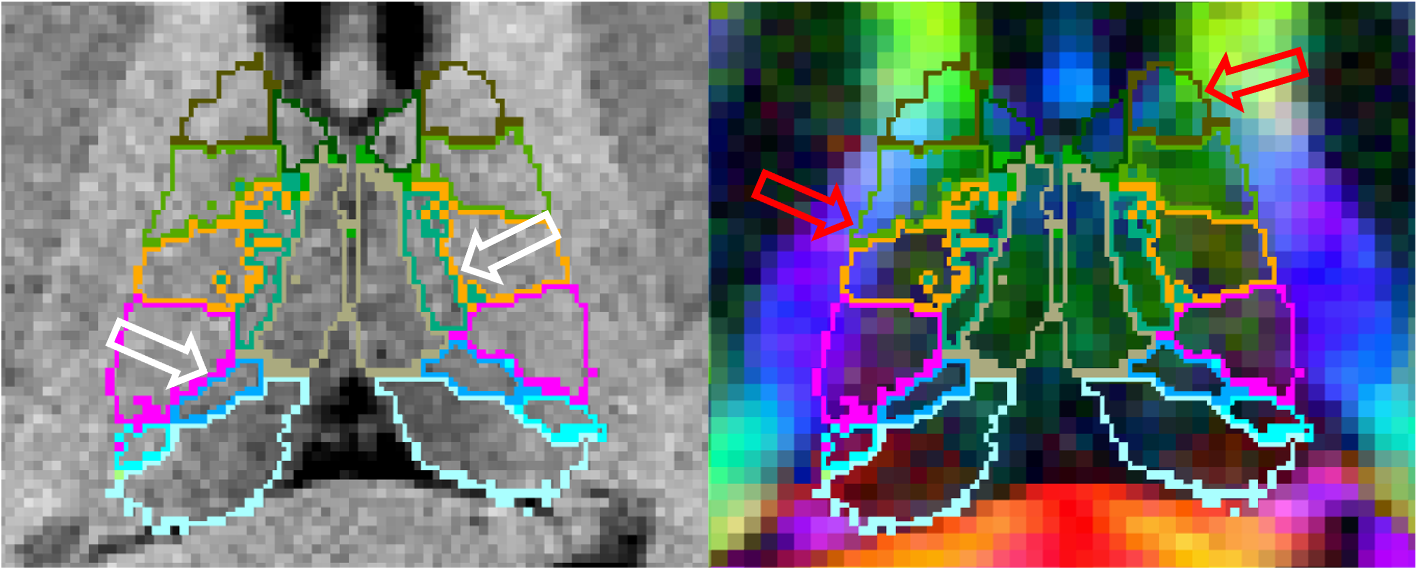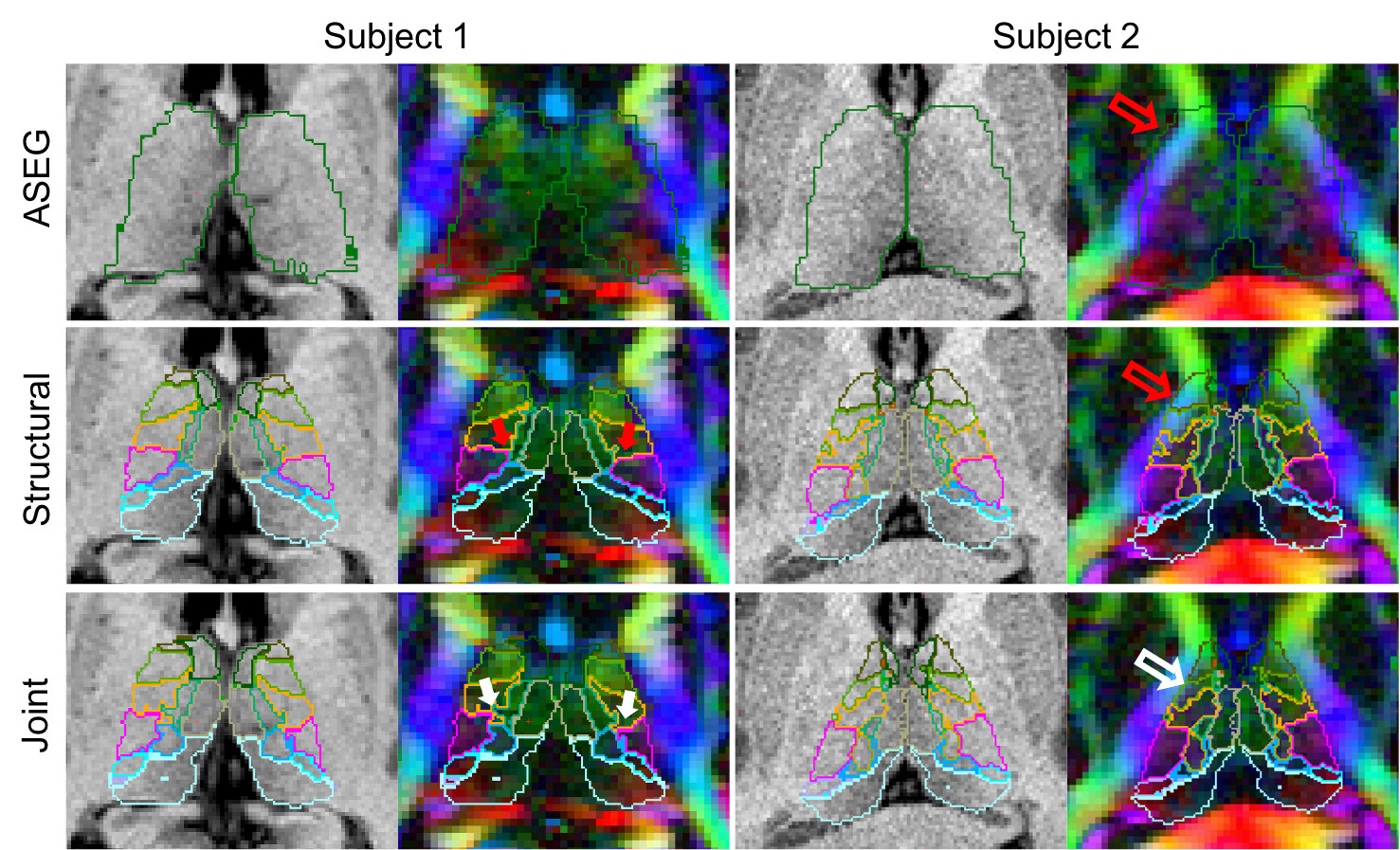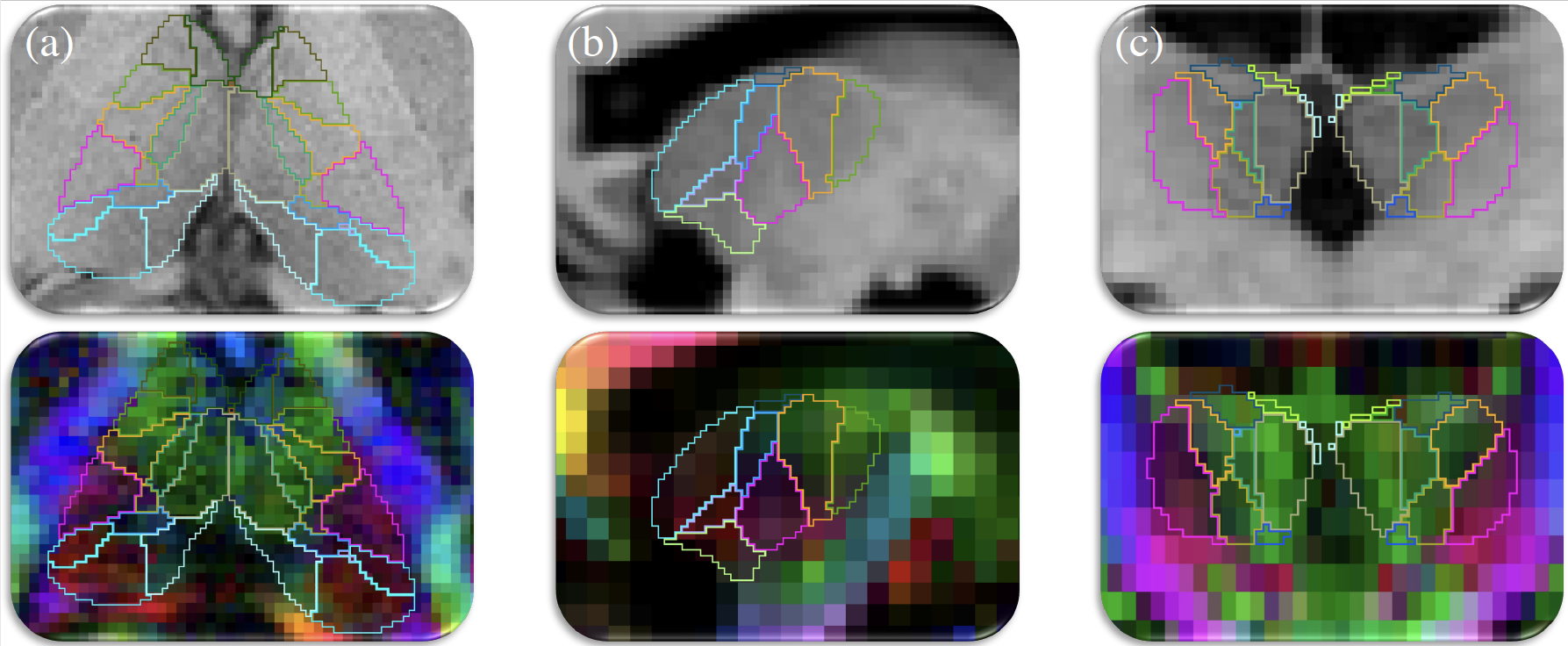Joint segmentation of thalamic nuclei from T1 scan and DTI
Authors: Henry Tregidgo and Juan Eugenio Iglesias
E-mail: h.tregidgo [at] ucl.ac.uk and jiglesiasgonzalez [at] mgh.harvard.edu
Rather than directly contacting the author, please post your questions on this module to the FreeSurfer mailing list at freesurfer [at] nmr.mgh.harvard.edu
If you use these tools in your analysis, please cite:
* Accurate Bayesian segmentation of thalamic nuclei using diffusion MRI and an improved histological atlas. Tregidgo HFJ, Soskic S, Althonayan J, Maffei C, Van Leemput K, Golland P, Insausti R, Lerma-Usabiaga G, Caballero-Gaudes C, Paz-Alonso PM, Yendiki A, Alexander DC, Bocchetta M, Rohrer JD, Iglesias JE., NeuroImage, 274, 120129,(2023)
Additionally for the CNN implementation:
* Domain-agnostic segmentation of thalamic nuclei from joint structural and diffusion MRI. Tregidgo HFJ, Soskic S, Olchany MD, Althonayan J, Billot B, Maffei C, Golland P, Yendiki A, Alexander DC, Bocchetta M, Rohrer JD, Iglesias JE. (Under review)
See also: ThalamicNuclei
Contents
- Motivation and General Description
- Bayesian tool
- Convolutional neural network (CNN)
1. Motivation and General Description
The ThalamicNuclei subfields module produces a parcellation of the thalamus into 25 different nuclei by applying a probabilistic atlas built with histological data to structural MRI volumes. However the lack of contrast in some structural scans can cause difficulty in correctly identifying boundaries that are more easily identifiable in modalities such as diffusion weighted MRI. For example, it often leaks on on to the corticospinal tract due to the lack of contrast on T1 images (while this is a boundary that is clearly visible in diffusion-weighted images):

For this reason we have improved our method by incorporating information from diffusion imaging, specifically diffusion tensor imaging (DTI). To do this we not only incorporate a DTI likelihood term into our Bayesian framework but also modify our atlas to allow modelling of DTI specific inhomogeneities such as with white matter tracts or between the medial and lateral portions of the PuM. This results in improved identification of both interior and exterior thalamic boundaries.

Additionally we address partial volume effects, present in DTI volumes with large voxels, by providing a convolutional neural network (CNN) that is trained to cope with large voxels of variable size. This CNN can segment the thalamic nuclei from T1 and diffusion MRI data obtained with virtually any acquisition, solving the problems posed by partial volume effects to Bayesian segmentations.

2. Bayesian Tool Usage
This module is currently being integrated into the Python framework that unifies the subregion segmentation modules and will be available soon.
3. CNN Tool Usage
This software requires four registered input volumes, which are produced by the standard FreeSurfer/ TRACULA pipelines. These are: 1. A bias corrected whole brain T1 such as the norm.mgz output from the main FreeSurfer stream ("recon-all") 2. A whole brain segmentation given by recon-all (aseg.mgz) 3. A fractional anisotropy volume such as dtifit_FA.nii.gz produced by the TRACULA module 4. A 4D volume containing the principle direction vector for each DTI voxel (eg. dtifit_V1.nii.gz from TRACULA)
An example workflow for obtaining these volumes would be:
Run FreeSurfer's main recon-all stream:
recon-all -all -s <subjid>
where <subjid> is the name of the subject.
Run Tracula:
trac-all -prep -s <subjid> -I <dicomfile>
where <dicomfile> is the path to the diffusion weighted MRI dicoms (see trac-all).
Apply the registrations to the structural images (note that we do not resample; we just update the header).
mri_vol2vol --mov <subjid>/mri/norm.mgz --o <subjid>/mri/norm.dwispace.mgz --lta <subjid>/dmri/xfms/anatorig2diff.bbr.lta --no-resample --targ <subjid>/dmri/dtifit_FA.nii.gz mri_vol2vol --mov <subjid>/mri/aseg.mgz --o <subjid>/mri/aseg.dwispace.mgz --lta <subjid>/dmri/xfms/anatorig2diff.bbr.lta --no-resample --targ <subjid>/dmri/dtifit_FA.nii.gz
Finally, run the CNN segmentation.
mri_segmentThalamicNucleiDTI_CNN --t1 <subjid>/mri/norm.dwispace.mgz --aseg <subjid>/mri/aseg.dwispace.mgz --fa <subjid>/dmri/dtifit_FA.nii.gz --v1 <subjid>/dmri/dtifit_V1.nii.gz --o /path/to/outputSegmentation.nii.gz --vol /path/to/measuredVolumes.csv --threads <nthreads>
Where <nthreads> is the number of threads to use in processing.
